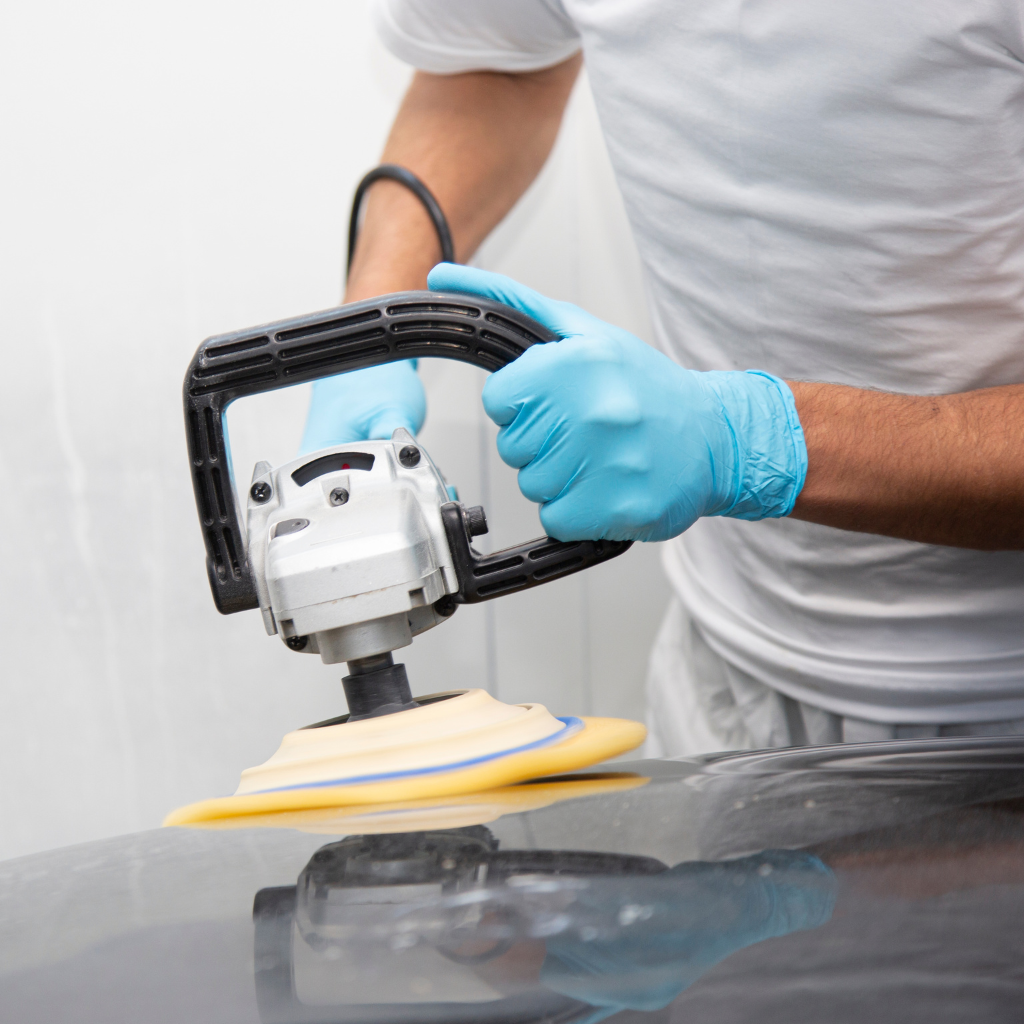Car wax and car polish serve distinct functions in vehicle maintenance. Car polish is used primarily to smooth and refine the paint surface, removing minor imperfections through mildly abrasive compounds. Conversely, car wax provides a protective coating, safeguarding the paint against environmental elements and UV damage while enhancing its gloss. Understanding the specific roles and best benefits of each can greatly improve your vehicle’s appearance. Further exploration can offer deeper insights into their ideal application and effects.
Key Takeaways
- Car polish contains abrasives to remove imperfections, while car wax adds a protective seal.
- Polish enhances the car’s detail by smoothing the paint; wax preserves gloss and protects against elements.
- Wax is made of natural waxes and synthetic polymers, unlike polish, which has abrasive compounds.
- The application sequence is crucial: polish first to correct the paint, then wax to protect it.
- Car polish is used for aesthetic restoration, whereas car wax extends paint longevity and enhances vehicle resale value.
What Are the Key Differences Between Car Wax and Car Polish?
In evaluating car wax and car polish, it is essential to distinguish their respective impacts on a vehicle’s paint surface.
Car wax primarily serves as a protective coating that enhances the paint’s gloss and shields it from environmental elements. In contrast, car polish is used to remove minor surface imperfections and restore shine.
Determining which product to apply first depends on the specific condition of the car’s paint and the desired outcome of the detailing process.
Understanding the Basics: Car Wax vs Car Polish
While both car wax and car polish are used to enhance a vehicle’s appearance, they serve distinctly different purposes and are composed of different materials.
Here are the key distinctions:
- Purpose: Car polish helps remove minor scratches and imperfections from the paint surface, preparing it for waxing. Car wax provides a protective layer to preserve the glossy finish and enhance paint protection.
- Composition: Car polish contains abrasives that cleanse the paint, while wax is primarily a blend of natural waxes and synthetic polymers that seal the paint.
- Application: Applying car wax follows polishing to guarantee the paint surface is smooth and defects are minimized.
- Outcome: Polish restores a shiny car appearance; wax prolongs this condition by shielding against environmental elements.
How Does Each Product Affect the Car’s Paint Surface?
Car wax and car polish distinctly influence the paint surface of a vehicle, serving unique functional roles in automotive maintenance.
Car polish is primarily used for removing imperfections from the car’s surface, such as swirl marks and minor scratches. It works by slightly abrasive compounds that smooth the paint job, enhancing its overall appearance.
Conversely, car wax is applied after polishing to provide a protective layer. This layer safeguards the paint against environmental damage and UV rays while also imparting a significant shine and smooth finish.
Fundamentally, while car polish focuses on enhancing the paint’s condition by corrective measures, car wax aims to preserve the current state of the paint job by adding a durable shield.
Which Should You Use First: Car Polish or Wax
Understanding the correct sequence and differences between car wax and car polish is fundamental to achieving ideal vehicle maintenance and aesthetics.
When considering car polish vs wax, the order of application is essential:
- Polish First: Car polish contains abrasive particles designed to remove minor surface imperfections. Using car polish, first prepare the paint by smoothing out scratches and blemishes.
- Type of Car Polish: Confirm the type of car polish used is suitable for your vehicle’s paint condition, as it directly affects the surface.
- Car Wax Application: After polishing, car wax is applied. Car wax provides a protective coating, enhancing gloss and guarding against environmental elements.
- Benefits of Wax: Wax helps seal the polish, offering lasting protection and shine. Using wax after polishing optimizes both products’ effects.
Should You Wax or Polish Your Car for the Best Results?
Determining whether to wax or polish a vehicle hinges on the desired outcome of the car care process.
Waxing offers a protective layer that guards the paint against environmental elements and enhances the car’s shine.
Conversely, polishing primarily addresses surface imperfections and enhances detail, making it an essential step for those focusing on the aesthetic restoration of their vehicle’s exterior.
Benefits of Waxing Your Car: A Protective Layer
Protection serves as a fundamental benefit when waxing a vehicle, providing a durable barrier against environmental hazards. Waxing not only enhances the aesthetic appeal of a car but also plays a critical role in maintaining its integrity.
Here are the primary benefits:
- Environmental Defense: Wax creates a protective layer that shields the car’s paint from environmental elements like dust, dirt, and pollutants.
- UV Protection: Regular waxing protects against harmful UV rays, preventing sun damage and oxidation to the paint.
- Enhanced Resale Value: A well-maintained exterior can greatly preserve the resale value of the vehicle.
- Durability: The protective layer on the paint extends the longevity of the car’s finish, reducing the frequency of paint-related repairs.

How Polishing Helps in Car Detailing
While waxing offers a robust protective layer for a car’s exterior, polishing plays an essential role in enhancing the vehicle’s aesthetic by removing imperfections and preparing the surface for waxing.
Car polish helps in car detailing by utilizing abrasive compounds to smooth out the surface of the car. These abrasives minutely wear down the surface, effectively diminishing scratches and blemishes.
The benefits of car polish are manifold; not only does it improve the look of the paint, but it also creates a smoother base for applying wax, which can adhere better and last longer.
Depending on the condition of the car’s exterior, different types of car polish can be used, ranging from mild to highly abrasive, to achieve the desired finish.
When to Choose Wax Over Polish for Car Care
How do you decide whether to wax or polish your car for ideal care? Choosing between car wax and car polish depends on your car’s specific needs and the desired outcome. Here are the factors to evaluate:
- Protection: Wax your car if the primary goal is to protect the paint. Wax is a protective barrier against UV rays and contaminants.
- Longevity: Opt for quality car wax if you prefer a solution that doesn’t require frequent applications; car wax can last several months.
- Ease of Application: Choose wax if you seek a product that is easy to apply and maintain.
- Finish: Use car wax to achieve a shiny, glossy finish that enhances your car’s aesthetic appeal.
Reapply wax periodically to maintain protection and shine.
How to Properly Wax and Polish Your Car?
Applying car wax correctly involves a series of strategic steps to guarantee a protective and glossy finish.
Utilizing car polish effectively requires understanding its composition and the appropriate application technique to enhance the vehicle’s shine.
Common errors in both waxing and polishing processes can considerably detract from the aesthetic and protective qualities of these treatments.
Steps to Apply Car Wax Properly
To apply car wax effectively, begin by making certain that the vehicle’s surface is impeccably clean and dry.
Here are the steps to apply car wax properly:
- Choose a Shaded Area: Apply in a shaded area to prevent the wax from drying too fast, which is common in direct sunlight.
- Apply a Small Amount: Use a foam applicator pad to apply a thin layer of wax. A small amount is sufficient to achieve a smooth surface.
- Use Even Strokes: Spread the wax using tight, circular motions to make sure an even coat covers all areas.
- Buff with a Soft Cloth: After the wax has dried to a haze, use a soft cloth to buff the surface to a high shine, making sure all residue is removed.
How to Use Car Polish for Maximum Shine
Achieving maximum shine on a vehicle’s exterior begins with the proper application of car polish, an essential step that precedes the waxing process.
To use car polish effectively, first make sure the car’s surface is clean and dry. Apply a small amount of high-quality car polish to a soft, clean microfiber cloth or a foam applicator pad. Use gentle, circular motions to work the polish into the surface, focusing on one section at a time.
This technique helps to minimize swirl marks and enhances the car’s shine. Let the polish haze slightly before buffing with a clean microfiber cloth to reveal a glossy, high-quality finish.
Regular detailing of your car with polish makes certain the car remains looking its best and achieves that perfect shine.
Common Mistakes in Polishing and Waxing
While proper application techniques for car polish can greatly enhance a vehicle’s appearance, errors in both polishing and waxing can compromise the final results. Here are common missteps:
- Choosing the Wrong Product: Not understanding the difference between wax and polish leads to improper use. Polish is for correcting small scratches, while carnauba wax protects the surface.
- Incorrect Application Method: Utilizing a dirty or inappropriate applicator pad can introduce more scratches rather than removing them.
- Over-Polishing: Excessive polishing can damage the paint. Car polishing depends on knowing when to stop to avoid harming the surface.
- Inadequate Surface Preparation: Failing to thoroughly clean the surface before applying paste wax or polish can trap dirt, undermining the process and effectiveness of car wax, which helps shield the paint.
What Types of Car Polish and Wax Are Available?
In the domain of automotive detailing, various types of car polishes and waxes are designed to meet distinct maintenance needs.
Car polishes vary in their chemical composition and intended use, providing either gentle cleaning or deep abrasion for surface imperfections.
Car waxes are available in paste, liquid, and spray forms, each offering different levels of protection and ease of application depending on the paint condition and type of vehicle.
Types of Car Polish: What Each Contains
Understanding the various types of car polish is essential for selecting the right product for your vehicle’s maintenance needs.
The composition and intended use of each type highlight the differences between Polish formulations and their applications.
- Abrasive Car Polish: Contains micro-abrasives to remove minor paint imperfections and restore gloss. It is ideal for older vehicles with dull, oxidized paint.
- Non-Abrasive Car Polish: Focuses on enhancing shine without altering the paint surface, suitable for newer cars.
- Ceramic Car Polish: Infuses nano-ceramic particles to provide a durable protective layer and high gloss.
- Spray-On Car Polish: Offers a quick, convenient application, often with added elements for minor correction and shine enhancement.

Exploring Different Car Wax Options: Paste, Liquid, and Spray
After examining the varieties of car polish and their specific compositions, attention now shifts to the different types of car wax available: Paste, liquid, and spray.
Paste wax offers excellent durability and a deep, glossy finish. Typically, this type of automotive wax takes more time to apply but offers lasting protection and enhancement to your car’s aesthetic.
Liquid wax, on the other hand, is easier to apply and is suitable for those taking care of their car with efficiency in mind.
Spray waxes offer the quickest application and are ideal for frequent use, although they might not last as long as paste waxes.
When deciding between car wax options, one must consider how much time one can dedicate to the application and what level of protection one desires.
Choosing the Right Product for Your Car’s Paint
Selecting the appropriate car care product often hinges on understanding the specific needs of your vehicle’s paint. Here is a guide to choosing the right wax or polish:
- Car Wax: Ideal for adding a protective layer that enhances the shine and appearance. Available in paste, liquid, and spray forms, it suits varying preferences in application techniques.
- Car Polish: Best for smoothing the surface and minimizing imperfections. Its formulations often include mild abrasives to assist in maintaining a flawless finish.
- Synthetic Polymer Wax: Offers a durable barrier against environmental damage, providing longer-lasting protection than natural waxes.
- Combination Products: Some products combine wax and polish for convenience, catering to those seeking both protective and corrective solutions in one application.
Understanding the Environmental Impact of Car Wax and Polish
As the automotive industry progresses, the environmental repercussions of car care products, particularly waxes and polishes, warrant critical examination.
Investigations into eco-friendly car wax options reveal varying degrees of biodegradability and chemical compositions that may influence ecosystem health.
Concurrently, the potential environmental hazards posed by traditional car polishes, alongside emerging sustainable alternatives, underscore the necessity for informed product selection by consumers.
Eco-Friendly Car Wax Options
While conventional car waxes and polishes can enhance vehicle appearance, their environmental impact has led to growing interest in eco-friendly alternatives.
Eco-friendly car waxes offer several benefits, ensuring both vehicle care and environmental responsibility.
- Biodegradable Ingredients: These waxes are typically made from natural substances that break down easily without harming the ecosystem.
- Improved Packaging: Often, sustainable waxes come in recyclable or biodegradable packaging, reducing waste.
- Protection from Debris: Like traditional waxes, eco-friendly options provide a smooth coating that helps protect the car’s surface from dirt and debris, ensuring the best results in maintaining the vehicle’s appearance.
Are Car Polishes Harmful to the Environment?
Although eco-friendly car waxes offer a sustainable choice, the environmental impact of car polishes remains a significant concern.
Car polishes, designed to remove a microscopic layer of paint to reduce the appearance of scratches and oxidation, contain chemicals that can be harmful. These substances may contribute to environmental degradation when washed into waterways, affecting aquatic life and water quality.
The protective benefits of car polish against sun and dust while enhancing a vehicle’s aesthetic necessitate a careful approach to mitigate potential harm. Users must consider the ecological footprint of their chosen products, as the ingredients in car polishes can accelerate corrosion if not properly managed, further complicating their environmental impact.
Sustainable Alternatives for Car Care
Given the concerning environmental impacts of traditional car polishes and waxes, the shift towards sustainable alternatives has become imperative for environmentally conscious consumers.
Here are key differences between car care products that can help car enthusiasts keep their vehicles in good condition while minimizing ecological footprints:
- Biodegradable Ingredients: Sustainable car waxes and polishes use natural, biodegradable compounds that break down without harming the environment.
- Non-Toxic Formulations: These products avoid harmful chemicals, ensuring safety for both the user and the planet.
- Eco-Friendly Packaging: Manufacturers opt for recycled or recyclable materials to package goods, reducing waste.
- Water-Saving Products: Some eco-friendly options facilitate waterless washing, preserving water resources and protecting the clear coat without compromising on giving your car a pristine look.
Conclusion
In summary, discerning the appropriate application and type of car wax and polish is essential for ideal vehicle maintenance. Utilizing these products not only enhances the aesthetic appeal but also provides protective benefits to the car’s surface. Professionals should consider the environmental implications of their choices, opting for products that minimize ecological impact. Regularly scheduled treatments, tailored to the car’s exposure and condition, guarantee longevity and preservation of the vehicle’s exterior integrity.






